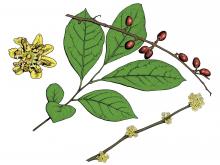Trees, Shrubs and Woody Vines
Media

Species Types
Scientific Name
Sambucus canadensis
Description
Common elderberry is a colony-forming shrub with opposite compound leaves. Its large, flattened clusters of small white flowers produce purple or black berrylike fruits.
Media

Species Types
Scientific Name
Hypericum prolificum (formerly H. spathulatum)
Description
Shrubby St. John’s-wort has shiny, somewhat leathery, opposite leaves, 2-edged twigs, and flowers with 5 bright yellow petals and many stamens. A shrub growing to 6 feet tall, it is scattered nearly statewide.
Media

Species Types
Scientific Name
Hypericum hypericoides (formerly Ascyrum hypericoides)
Description
St. Andrew’s cross is a small, sprawling shrub up to 3 feet tall, with smooth, opposite leaves, reddish flaky bark, and distinctive yellow flowers with 4 petals. It grows in the southern half of Missouri.
Media

Species Types
Scientific Name
Quercus spp.
Description
Oaks are the most important group of trees in Missouri, in both human and ecosystem value. They dominate most of the forests, woodlands, and savannas in the state. Learn more about our 22 species.
Media

Species Types
Scientific Name
Symphoricarpos orbiculatus
Description
Buckbrush, or coralberry, grows throughout Missouri. This familiar thicket-forming shrub bears dense clusters of pinkish-red berries that persist through most of the winter.
Media

Species Types
Scientific Name
Ribes missouriense
Description
Missouri gooseberry is our state’s most widespread and common gooseberry. People brave its prickly stems to collect its tart, tasty fruits to make pies, jams, and jellies.
Media

Species Types
Scientific Name
Cercis canadensis
Description
Eastern redbud is a native shrub or small tree that is distinctly ornamental in spring with small, clustered, rose-purple flowers covering the bare branches before the leaves.
Media

Species Types
Scientific Name
Juniperus virginiana
Description
By far the most common native conifer in the state, eastern red cedar is useful for its aromatic, red wood and beloved for its greenery, its resinous blue “berries,” and the spicy odor it lends the outdoors.
Media

Species Types
Scientific Name
Lonicera maackii (Amur) and Lonicera x bella (bella)
Description
If there’s a giant green thicket in your woods, you may have a bush honeysuckle infestation. These invasive plants are shrubby natives of Asia. In America, where they have no natural controls, they leaf out early, grow fast, spread fast, and form dense thickets that crowd out native forest plants.
Media

Species Types
Scientific Name
Lindera benzoin
Description
Spicebush is a stout, smooth, aromatic shrub of the damp woods. Its eye-catching, early-blooming flowers and its bright red fruits make it a popular native ornamental for shade gardens.
See Also
About Trees, Shrubs and Woody Vines in Missouri
There are no sharp dividing lines between trees, shrubs, and woody vines, or even between woody and nonwoody plants. “Wood” is a type of tissue made of cellulose and lignin that many plants develop as they mature — whether they are “woody” or not. Trees are woody plants over 13 feet tall with a single trunk. Shrubs are less than 13 feet tall, with multiple stems. Vines require support or else sprawl over the ground.





















